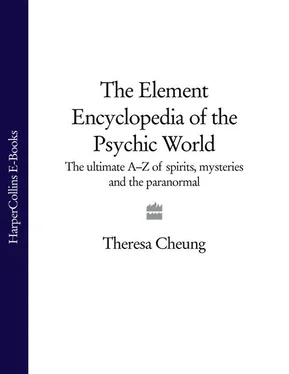 Apparitions in cases suggestive of reincarnation: cases when the deceased appears in a dream to a member of the family into which it will be reborn. Such dreams occur frequently among Native American tribes of the Northwest and in Turkey, Burma and Thailand.
Apparitions in cases suggestive of reincarnation: cases when the deceased appears in a dream to a member of the family into which it will be reborn. Such dreams occur frequently among Native American tribes of the Northwest and in Turkey, Burma and Thailand.
A large number of theories have been put forward to explain apparitions, but none explain all the different types. Society for Psychical Research founders Edmund Gurneyand Frederick Myersat first believed apparitions were mental hallucinations that had no physical reality either produced by telepathyfrom the dead to the living or projected out of the percipient’s mind in the form of an image. Gurney also believed that collective apparitions were a product of telepathy among the living, projected by the primary percipient to others around him or her. However, telepathy among the living does not explain why witnesses in collective sightings notice different details.
Myers, who believed strongly in survival after death, began to doubt the telepathic theory as early as 1885. In his landmark book Human Personality and Its Survival after Death (1903), he suggested that the apparitions consisted of a ‘phan-tasmogenic centre’, a locus of energies that could be perceived by the most psychically sensitive people. He conceived of a ‘subliminal consciousness‘ as the basis from which the consciousness springs and which survives the body after death. He theorized that the subliminal consciousnesswas receptive to extrasensory input and that apparitions appeared to psychically receptive people.
Other theories that have been advanced subsequently about apparitions suggest they are:
 Idea patterns or etheric images produced by the subconscious mind of the living.
Idea patterns or etheric images produced by the subconscious mind of the living.
Astral or etheric bodies of the agents.
An amalgam of personality patterns, which in the case ofhauntings are trapped on a psychic or psi field.
Projections of the human unconscious, a manifestation of an unacknowledged need or guilt.
Vehicles through which the T, the thinking consciousness, takes on a personality as well as a visible form.
Projections of will and concentration; see Thoughtform.
 True spirits of the dead.
True spirits of the dead.
Localized physical phenomena directed by an intelligence or personality.
Recordings or imprints of vibrations impressed upon some sort of psychic ether. In Eastern mystical philosophy, the cosmos is permeated by a substance called the Akasha. Oxford philosopher HH Price called this substance psychic ether’, a term adopted by some psychical researchers to suggest that if all events are recorded on some invisible substance, then perhaps psychically tuned people can get glimpses of these records and get a playback. See Akashic Records.
It is unlikely that any one theory can explain all apparitions, and it is conceivable that some apparitions are created by the living, that some have their own reality, that some are hallucinations and that some are psychic recordings.
Twentieth-century psychical researcher Andrew Mackenzie suggested that the ability to have hallucinations could be a function of personality. In his studies he found that one-third of cases occurred just before or after sleep, or when the percipient was woken in the night. Other experiences took place when the witness was in a state of relaxationor doing routine work such as housework, or concentrating on some activity such as reading a book. Only when the external world was shut out was the unconscious able to release impressions, which sometimes took the form of an apparition.
English psychical researcher G Tyrrell also made this link between dreamlike states and sightings of apparitions. Tyrrell theorized that there were two stages in an hallucinatory experience. In stage one the witness unconsciously experiences the apparition, and in stage two the information from stage one is processed from the unconscious in dreams or hallucinations with the required details added, such as clothing and objects.
Also known as applied parapsychology and psionics, applied psi is a branch of parapsychologythat assumes psychic ability exists and seeks ways to apply it in everyday life.
Applied psi is used today when anyone acts on his or her intuitionto make a decision. Experimental studies of applied psi date back to the eighteenth century, but it wasn’t until the twentieth century that the discipline was seriously explored. In 1963 the Newark College of Engineering in New Jersey became one of the first engineering centres in the US to explore psiability in people. Researchers found that successful people use psi and precognitiondaily in their jobs in the form of intuition, hunchesand gut feelings. In the early 1980s, American parapsychologist Jeffrey Mishlove urged parapsychologists to assume that psi existed and to focus on ways to use it in everyday life. By 1984 applied psi did become an informal part of a number of fields, including archaeology, agriculture, executive decision-making, scientific discovery, military intelligence, criminal investigations and weather prediction. However, over subsequent years the erratic nature of psi made it an unreliable tool.
Some experiments raised interesting questions as to how effective applied psi can be when it comes to making financial investments. It is not uncommon for people to place a bet or buy and sell stock on gut instinct. Experiments, such as one conducted by the St Louis Business Journal in 1982, compared the results of a group of experienced brokers with a psychic. The stocks picked by the brokers fell in value, but the ones picked by the psychic rose. Despite such successes, however, widespread use of applied psi in the stock market has never materialized - if it did it would probably spell the end of the stock market, thriving as it does on unpredictability and chance.
In his Encyclopedia of Psychic Science (1933), Hungarian psychical researcher Nandor Fodordefined apports as the ‘arrival of various objects through an apparent penetration of matter’, one of the most baffling phenomena of spiritualism, he thought. Apports are objects that mediumsclaim to be able to produce from thin air or transport through solid matter, and to this day they remain as mysterious as ever.
The majority of apports are everyday small objects such as rings, sweets and pebbles, although some can be large and unusual such as books, garden tools, live animals and birds. When spiritualism was at its most popular apports were commonplace at séances. Sufis, mystical adeptsof Islam, and Hindu swamis are also renowned for the apports they produce. Some mediums have been exposed as frauds, producing apports that were hidden under the table or on their person prior to the séance, which is held in the dark, making trickery easier. Some adepts also have been exposed as frauds, but there are adepts and mediums whose reputations hold. Sai Babaof India, for example, seems to be able to produce apports, such as sweets, banquets of hot food, statues and many other objects, from his closed fist, while others are pulled from the sand.
Читать дальше

 Apparitions in cases suggestive of reincarnation: cases when the deceased appears in a dream to a member of the family into which it will be reborn. Such dreams occur frequently among Native American tribes of the Northwest and in Turkey, Burma and Thailand.
Apparitions in cases suggestive of reincarnation: cases when the deceased appears in a dream to a member of the family into which it will be reborn. Such dreams occur frequently among Native American tribes of the Northwest and in Turkey, Burma and Thailand.
![Theresa Cheung - The Dream Dictionary from A to Z [Revised edition] - The Ultimate A–Z to Interpret the Secrets of Your Dreams](/books/692092/theresa-cheung-the-dream-dictionary-from-a-to-z-r-thumb.webp)









